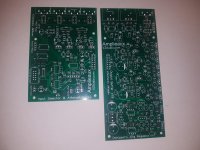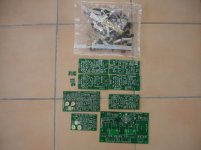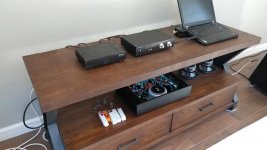Another current-driven front-end
Gentlemen - a rather interesting experiment here:
Luxfront - inspired by Luxman from 80's
Current-driven front-end with folded cascode, showing excellent characteristics.
The cool thing about it - it's fast enough and rock stable even with the lightest compensation.
Elegant topology from Luxman engineers
Gentlemen - a rather interesting experiment here:
Luxfront - inspired by Luxman from 80's
Current-driven front-end with folded cascode, showing excellent characteristics.
The cool thing about it - it's fast enough and rock stable even with the lightest compensation.
Elegant topology from Luxman engineers

Just arived!
Thanks Jeff!🙂
A lot of new IPS for testing😎
The absolute protection to keep every amplifier under control😉
Thanks Jeff!🙂
A lot of new IPS for testing😎
The absolute protection to keep every amplifier under control😉
Attachments
Last edited:
Ok i will wait,then i will try to find what IPS parts matching or guide me what IPS you want seeing first tested😉Cool! I'll send you some build info to go with them later today.
Last edited:
that's alot of boards for output protection. is the 28 pin dip a PIC cpu?
speaker output needs , current sense high and low side , DC voltage at output and High frequency > 20khz
power On delay 4 - 6 seconds, power off disconnect .25 second
over / under voltage an asset but not required
Thermal shutdown adds complexity and not required if heat sink is correct size for power output
speaker output needs , current sense high and low side , DC voltage at output and High frequency > 20khz
power On delay 4 - 6 seconds, power off disconnect .25 second
over / under voltage an asset but not required
Thermal shutdown adds complexity and not required if heat sink is correct size for power output
Last edited:
The protection system is Arduino based. Atmega328. There's 5 different input boards in the picture along with the protection system.
that's alot of boards for output protection. is the 28 pin dip a PIC cpu?
speaker output needs , current sense high and low side , DC voltage at output and High frequency > 20khz
power On delay 4 - 6 seconds, power off disconnect .25 second
over / under voltage an asset but not required
Thermal shutdown adds complexity and not required if heat sink is correct size for power output
Protection systems should cover all possibilities. Properly sized heat sinks don't do you any good if someone inadvertently covers them or if a bias circuit goes bad. It's silly not to protect the amp from this. On delay needs to last as long as the amp is unstable on start up. This is different in every design and is also affected by softstart operation.
good point, I wound not run an amp with the vents covered but someone else might.
A small thermistor is easy to add. I was thinking from the point of the protection being exclusively for your expensive speakers connected to the amp.
I placed a 7.5v zener accross the gates of the mosfets in case the bias circuit should open, if the bias transistor shorted there would be some distortion possibly only detectable with a scope
A small thermistor is easy to add. I was thinking from the point of the protection being exclusively for your expensive speakers connected to the amp.
I placed a 7.5v zener accross the gates of the mosfets in case the bias circuit should open, if the bias transistor shorted there would be some distortion possibly only detectable with a scope
In our amp control solution, we protect not only the speakers, but the amplifier as well.
It's an integrated control board, managed by a micro-controller.
For example, if in the end of soft-start sequence, DC offset sensor or over-current sensor will indicate the offset above the allowed threshold, the board will not connect the speaker - it will abort the sequence, shut down the amp and indicate the reason for doing so.
See the link in my signature for more details.
It's an integrated control board, managed by a micro-controller.
For example, if in the end of soft-start sequence, DC offset sensor or over-current sensor will indicate the offset above the allowed threshold, the board will not connect the speaker - it will abort the sequence, shut down the amp and indicate the reason for doing so.
See the link in my signature for more details.
Hi guys,
I had the pleasure to evaluate a Accuphase C-200 pre-amp and P-300 power amp this weekend. Sat in storage for ~20 years.
I was looking at the schematics for the P-300. It has a nice protection feature that at power up, measures the load R through the N/C speaker relay contacts to determine if the load is too low before it energizes the speaker relay. If the load R is too low, <2ohms, it starts to flash the meter lamps. Something rather easy to do with a MCU with an A/D converter.
I had the pleasure to evaluate a Accuphase C-200 pre-amp and P-300 power amp this weekend. Sat in storage for ~20 years.
I was looking at the schematics for the P-300. It has a nice protection feature that at power up, measures the load R through the N/C speaker relay contacts to determine if the load is too low before it energizes the speaker relay. If the load R is too low, <2ohms, it starts to flash the meter lamps. Something rather easy to do with a MCU with an A/D converter.
Here's the first stage of a preamp using a modified version of the Ampliwire input. it also uses Ostripper's version of the Jung regulator for the analog supply.
Where are the schematics for these pcbs?
Hi guys,
I had the pleasure to evaluate a Accuphase C-200 pre-amp and P-300 power amp this weekend. Sat in storage for ~20 years.
I was looking at the schematics for the P-300. It has a nice protection feature that at power up, measures the load R through the N/C speaker relay contacts to determine if the load is too low before it energizes the speaker relay. If the load R is too low, <2ohms, it starts to flash the meter lamps. Something rather easy to do with a MCU with an A/D converter.
Any chance of uploading both schematics?
Where are the schematics for these pcbs?
Once this project progresses a bit farther I'll start a new thread in the analog line section of the forum. I have the boards populated and debugged and have done initial testing looking good and very quiet so far.
Attachments
Boards received
Jeff,
Received the VHEX+, protection, and PSU boards. All arrived safely. Woohoo! Now I just need to get those BOMs ordered.
The customer service with you guys is awesome. Very fast to respond to all of my emails: VZaudio is very good to deal with!
Cheers,
Greg
Jeff,
Received the VHEX+, protection, and PSU boards. All arrived safely. Woohoo! Now I just need to get those BOMs ordered.
The customer service with you guys is awesome. Very fast to respond to all of my emails: VZaudio is very good to deal with!
Cheers,
Greg
Hi Paul,
Took some time for me to think 🙂
There's one more option for "the best way to drop the voltage to the jfets" - cascode with bjts like ksc1845/a992 - the one I like the best. Slight parts count increase, but high scalability for almost any rails / output swing required without sacrificing stability. Agree?
With regards to what's next - I have good results, experimenting with multiple feedback loops, see the feedback arrangement in Sauberkeit-LT IPS. Another advantage of that kind of topology - the first voltage gain stage can run at low rails, being scaled-up at the next stage with the mirrors.
So, the idea now - replace the OpAmp with a simple discrete circuit, based on your self-biased jfet-based IPS. I will show you my option, demonstrating extremely promising results.
By the way, I have arranged soft-clipping in this "discrete OpAmp", resulting in very tube-like rounded shape even in deep clipping conditions.
I think - this is the way to go next 😉
Cheers,
Valery
I like considering jfet input Im thinking of the following options: J111 and J175 from fairchild.
I have a new addition to the VHex family up and running today. The Lichtstark-X is running smoothly and awaiting more in depth testing. It seems rock stable so far. DC offset remains within a couple mV. Clipping is nice. Another great design by Valery. I need to get a second channel running yet and give it a listen.
Hi
Did you have time to build the other and listen to it?
Thx again😁
Hi
Did you have time to build the other and listen to it?
Thx again😁
I haven't had time to build the second channel yet.
My VHEX+ build
A big thank you to Jeff and Valery for my build!!
Jeff was awesome at answering questions, and always available and quick to respond. Not possible without him.
Just finished it last Saturday.
Will post a full-build post later.
Making fantastic tunes at my house with the Martin Logan Montis. This amp is a sonic blockbuster. Period.
Cheers,
Greg
A big thank you to Jeff and Valery for my build!!
Jeff was awesome at answering questions, and always available and quick to respond. Not possible without him.
Just finished it last Saturday.
Will post a full-build post later.
Making fantastic tunes at my house with the Martin Logan Montis. This amp is a sonic blockbuster. Period.
Cheers,
Greg
Attachments
- Home
- Amplifiers
- Solid State
- Sons of VHex



